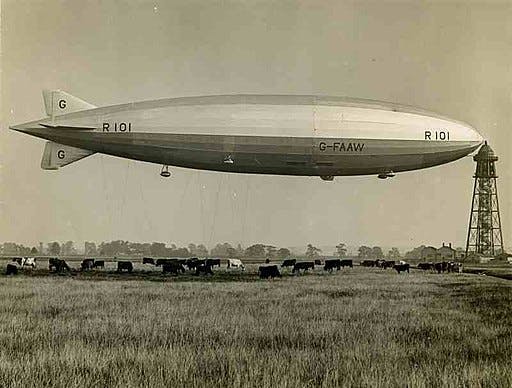The British Empire’s Doomed Dreams of Ruling the Skies Emerge in ‘His Majesty’s Airship’
World’s largest flying machine chased a dream that was never to be.

‘His Majesty’s Airship: The Life and Tragic Death of the World’s Largest Flying Machine’
S.C. Gwynne
Scribner, 307 pages
“Hello, Airplanes?” quips the titular spy of “Archer,” the FX animated series. “It’s blimps. You win.” That 2010 episode of the series, “Skytanic,” reflects the modern scorn heaped on those who believed that lighter-than-air vehicles — blimps and dirigibles — ever stood a chance against fixed-wing aircraft.
In “His Majesty’s Airship,” Pulitzer Prize finalist S.C. Gwynne paints a picture of why people a century ago bet on rigid airships — the R in the name of R101 — as having the best odds of crossing vast distances in comfort and style.
Airplanes a century ago were cramped, noisy, bone-chattering contraptions while the R101 was a luxury liner of the skies. Unlike blimps, which are just air-filled balloons, dirigibles had engineered skeletons with individual bladders filled with hydrogen, allowing room for cargo, passengers, and amenities we today see on cruise ships.
R101, ten stories high, carried all the pride and hubris of Britain when it launched from Bedford, England, on October 4, 1930, music blaring from speakers on its underside to awe-struck crowds below. After a planned refueling in Egypt, it was scheduled to land at Karachi, India, making the trip in four days versus the 12 it took by boat. Instead, wind sent R101 into a dive over France just 31 hours after takeoff, driving it into the ground where it burst into flames.
“I’ve always fancied the dirigible against the airplane for overhead haulage in the years to come,” said the imperialist and author, Rudyard Kipling. Compared to R101 and her sister ships, the first solo flight across the Atlantic by Charles Lindbergh in 1927 was a mere stunt.
In addition, “Lindbergh went the easy way,” Mr. Gwynne told me in our History Author Show interview, “west to east,” while an earlier dirigible, R34, did it the hard way, against the Gulf Stream, with 29 aboard in 1919. “There were moments like this you could point to and say, ‘Well, it really is a good idea. It really has potential to be the long-range air travel solution for the world.’”
Building R101 required gluing together the intestines of cattle with meticulous effort to build what Mr. Gwynn described as “a very large cheese wheel.” When construction fell behind schedule, the ship was rushed into the air, anyway, helping to seal its doom.
America and Britain perceived Germany’s zeppelins as a great success in World War I. Although they proved difficult to steer in bad weather and easy to bring down with incendiary rounds, the Kaiser’s “Baby Killers” captured the imagination of military men fearful of an emerging dirigible gap.
Although Britain’s empire covered a quarter of the globe after the war, Mr. Gwynne said it “had been creaky for a while,” and, “from the British point of view, R101 was serious on the level of the moonshot. They really thought, ‘This is going to change the world.’”
Uniting the empire by the sky would tie the commonwealth closer to London. It was the driving force behind Lord Christopher Birdwood Thomson. R101 was his brain child and he envisioned her maiden overseas journey ending with him being named as the new viceroy of India. Instead, they ended up burned and broken together.
Thomson’s ambition was also fueled by his romance with a Romanian princess, Marthe Bibesco. Thomson envisioned R101’s success would win hearts the world over including the one he coveted most.
This romantic dream fell short. “R101 goes down about 90 miles north of Paris in a hydrogen fire,” Mr. Gwynne said, “which has become very familiar at this point, but the world hadn’t seen the Hindenburg yet.” That disaster was seven years in the future.
Without film to capture R101’s death as it did the Hindenburg’s, its failure wasn’t seen as the end of the lighter-than-air era. America — using inert helium to solve the problem of hydrogen’s flammability — tried its hand at dirigibles for years, losing airships like the Shenandoah and Akron to crashes.
Forty-eight passengers died in the crash but, by various miracles, six survived. These lucky few included an engineer, Harry Leach, who was in R101’s smoking lounge for a cigarette break at the time of the crash. The compartment’s asbestos lining saved his life.
“I’m telling a broader story of the early history of aviation,” Mr. Gwynne said, “which includes all kinds of interesting things, but all gets wound around and into this larger story,” a human tale of “tragedy and doom” heralding “the end of the British Empire and its attempt to save itself.”
As with the explosion of Apollo 1 during testing, advancing humanity’s frontiers often has fiery setbacks. Dirigibles lost out to airplanes, but “His Majesty’s Airship” reminds us how those magnificent men in their flying machines persisted, chasing a dream of a future — and a resurgent empire — that was never to be.

